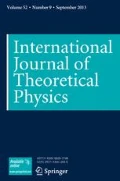Abstract
Quantities are defined operationally which qualify as measures of complexity of patterns arising in physical situations. Their main features, distinguishing them from previously used quantities, are the following: (1) they are measuretheoretic concepts, more closely related to Shannon entropy than to computational complexity; and (2) they are observables related to ensembles of patterns, not to individual patterns. Indeed, they are essentially Shannon information needed to specify not individual patterns, but either measure-theoretic or algebraic properties of ensembles of patterns arising ina priori translationally invariant situations. Numerical estimates of these complexities are given for several examples of patterns created by maps and by cellular automata.
Similar content being viewed by others
References
Alekseev, V, M., and Yakobson, M. V. (1981).Physics Reports,75, 287.
Allouche, J.-P., and Cosnard, M. (1984). Grenoble preprint.
Block, L., et al. (1980). Periodic points and topological entropy of 1-dimensional maps, inLecture Notes in Mathematics, No. 819, Springer, Berlin, 1980, p. 18.
Chaitin, G. J. (1979). Toward a mathematical definition of ‘life’, inThe Maximum Entropy Principle, R. D. Levine and M. Tribus, eds., MIT Press, Cambridge, Massachusetts.
Christol, G., Kamae, T., Mendes France, M., and Rauzy, G. (1980).Bulletin Societé Mathematique France,108, 401.
Collet, P., and Eckmann, J.-P. (1980).Iterated Maps on the Interval as Dynamical Systems, Birkhauser, Boston.
Crutchfield, J. P., and Packard, N. H. (1983).Physica,7D, 201.
Dias de Deus, J., Dilao, R., and Noronha da Costa, A. (1984). Lissabon preprint.
Eckmann, J. P., and Ruelle, D. (1985).Review of Modern Physics,57, 617.
Feigenbaum, M. (1978).Journal of Statistical Physics,19, 25.
Feigenbaum, M. (1979).Journal of Statistical Physics,21, 669.
Grassberger, P. (1984).Physica,10D, 52.
Grassberger, P., and Kantz, H. (1985).Physics Letters,113A, 235.
Grossmann, S., and Thomae, S. (1977).Zeitschrift für Naturforschung,32a, 1353.
Guckenheimer, J., and Holmes, P. (1983).Non-linear Oscillations, Dynamical Systems, and Bifurcations of Vector Fields, Springer, New York.
Györgyi, G., and Szepfalusy, P. (1985).Physical Review A,31, 3477; and to be published.
Hofstadter, D. R. (1979).Gödel, Escher, Bach, Vintage Books, New York.
Hogg, T., and Huberman, B. A. (1985). Order, complexity, and disorder, Palo Alto preprint,
Hopcroft, J. E. and Ullman, J. D. (1979).Introduction to Automata Theory, Lanaguages, and Computation, Addison-Wesley.
Martin, O., Odlyzko, A., and Wolfram, S. (1984).Communication in Mathematical Physics,93, 219.
Packard, N. (1983). Complexity of growing patterns in cellular automata, Institute of Advanced Study preprint.
Schuster, H. G. (1984).Deterministic Chaos, Physik-Verlag, Weinheim, West Germany.
Shannon, C. E., and Weaver, W. (1949).The Mathematical Theory of Communication, University of Illinois Press, Urbana, Illinois.
Sinai, Ya. (1985).Commentarii Mathematici Helvetici,60, 173.
Van Emden, M. H. (1975).An Analysis of Complexity, Mathematical Centre Tracts, Amsterdam.
Wagoner, S. (1985). Is pi normal;,Mathematical Intelligencer,7, 65.
Wolfram, S. (1983).Review of Modern Physics,55, 601 (1983).
Wolfram, S. (1984a).Physica,10D, 1.
Wolfram, S. (1984b).Communications in Mathematical Physics,96, 15.
Wolfram, S. (1985). Random sequence generation by cellular automata, Institute for Advanced Study preprint.
Author information
Authors and Affiliations
Rights and permissions
About this article
Cite this article
Grassberger, P. Toward a quantitative theory of self-generated complexity. Int J Theor Phys 25, 907–938 (1986). https://doi.org/10.1007/BF00668821
Received:
Issue Date:
DOI: https://doi.org/10.1007/BF00668821




